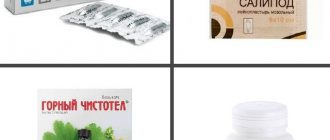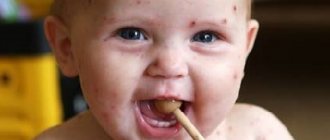Both adults and children are susceptible to fungal and infectious diseases. One of the most common ailments that mainly affects the female body is candidiasis (thrush). This disease is so common that it is diagnosed in almost every adult woman. Infantile thrush is no less common.
The nature of the disease and its causative agent are the same in both adults and children. The candida fungus (Candida albicans), which causes thrush, is constantly present in the human body (on the mucous membranes, genitals and occasionally internal organs), being part of the microflora, without causing harm and without showing any symptoms. Therefore, the disease is provoked not so much by the fungus itself, but by the state of the body and external factors that contribute to the growth of the fungus and the development of infection.
Children's vulvovaginal candidiasis most often affects adolescents (mainly girls) and newborns of both sexes.
There are two forms of the disease:
- a form with pronounced symptoms according to the standard clinical picture;
- asymptomatic form, which is detected only as a result of laboratory tests.
There are also such types of thrush in children (vulvar candidiasis in girls), as oral candidiasis (develops in the mouth of newborns) and genital candidiasis (mainly in preschoolers and adolescents). In any case, the child must be shown to a specialist, since the infection indicates a decrease in immunity, which can lead to even more complex and unpleasant consequences.
Content
- The causative agent of parasitic infection is pinworm
- Causes of pinworm infection
- What complications does the disease cause?
- Symptoms of the disease Acute period
- Chronic stage
Enterobiasis is an infection of the body with helminths - pinworms. Young children are at risk, but children of other ages can also be infected.
In gynecology, vulvitis is an inflammation of the mucous membranes of a woman’s external genitalia.
The inflammatory process covers the labia, clitoris, external urethral opening, anal area and surrounding tissues (pubis, inner thighs, etc.). At first glance, such a pathology should bypass children of the younger age group and affect only adult women of reproductive age. However, statistics show that acute vulvitis in girls of childhood and adolescence is the most common reason for visiting a pediatric gynecologist. In some cases, doctors even diagnose vulvitis in newborn girls.
To notice and provide medical assistance in time for the development of vulvitis is the most important task of responsible parents . Advanced acute vulvitis in a child can involve the vaginal mucous membranes in the inflammatory process, which leads to aggravation of the little patient’s condition and provokes the development of vulvovaginitis. In addition, the acute process gradually turns into a chronic form, which inevitably affects the sexual, reproductive and menstrual function of an adult representative of the fair sex. This inflammation is dangerous due to the formation of synechiae (adhesions) of the labia minora, erosion of the cervix and uterine body, as well as the addition of cystitis and urethritis.
The causative agent of parasitic infection is pinworm
Enterobiasis is caused by the pinworm parasite. This helminth is a roundworm belonging to the class of nematodes. It has some features in appearance. Females grow to a length of 9-12 mm, they have a “tail” - a pointed end. It severely injures the intestinal mucosa when the worm is in the body. Males are 2-3 times smaller than females, and their “tails” are curved in a spiral. Source: https://www.ncbi.nlm.nih.gov/pmc/articles/PMC2306321/ JP Caldwell Pinworms (Enterobius Vermicularis) Can Fam Physician. 1982 Feb; 28: 306–309.
Adult helminths live in the cecum and at the end of the small intestine. At night, females crawl out of the cecum through the anus. At this time, the person’s anal sphincter is relaxed, so nothing interferes with the worms. When the female pinworm emerges, she lays eggs in the perianal folds. There are a lot of eggs - up to 15 thousand. Having laid them, the female dies. The entire cycle of her life is about a month. The eggs are resistant to environmental factors and can remain viable for up to 3 weeks. They stain clothes and bedding.
After a few hours, the embryo from the egg becomes a larva, which itself begins to parasitize. This is how enterobiasis spreads. Pinworms can penetrate the thickness of the intestinal mucosa, causing the formation of granulomas. Sometimes worms crawl into the vagina, uterus and ovaries. Because of this, the female organs become inflamed.
What is genital herpes?
Genital herpes is one of the serious infectious diseases. The center of this disease is in the nerve cells of almost all organs. This fairly common disease belongs to the venereological group. This pathology is not hereditary.
Genital herpes is transmitted sexually, through kissing, and through shared objects (cutlery, toys, personal hygiene items). It is important to note that most infected people do not notice any symptoms at all. They may not realize that they pose a danger to others.
The incubation period of herpes is 7 days. The infection reaches its peak in one and a half months. The disease is prone to persistent progression with relapses. Symptomatic elements of the rash can be located grouped or separately. These are small blisters that appear on the swollen and reddened base of the mucous membrane of the genitourinary system, as well as on the skin of the perineum.
Here you will find a similar article on the topic of herpes on the body.
Genital herpes in children
Newborn babies have very weak immunity, so the disease can manifest itself in the first week after birth. The main signs are the appearance of hemorrhage in the form of dots on the genital mucosa, the presence of blisters, and redness of the skin. The temperature often rises, vomiting and diarrhea appear.
What complications does the disease cause?
When the parasite attaches to the intestinal wall, it secretes a harmful secretion and damages the mucous membrane. In the latter case, poorly healing ulcers form and hemorrhages occur. If tissues are deeply damaged, inflamed granulomas appear. They consist of abnormally overgrown cells, lymph and blood. Due to the fact that pinworms injure the intestines, children experience abdominal pain. The microflora is disrupted and dysbacteriosis occurs.
When the female crawls out, she damages the soft tissue. The perianal area is irritated by the secretion of the worm - abrasions, cracks, eczematous rash, and neurodermatitis appear. If the helminth penetrates the genitals of girls, endometritis and other gynecological diseases may develop.
In the presence of pinworms the acidity of the stomach decreases , food is digested worse, and the course of intestinal diseases becomes more complicated . Parasites reduce immunity, because of them the effectiveness of vaccinations decreases and the number of side effects from them increases. Medicine knows of cases where pinworms pierced the rectum and entered the abdominal cavity, followed by peritonitis.
Being in the organs of the gastrointestinal tract, parasites cause the following complications:
- inflammation of the pelvis and peritoneum;
- acute skin lesions in the perirectal area;
- stagnation of feces in the cecum;
- pyoderma;
- anemia;
- developmental delay of the child;
- disturbance of appetite and sleep; Source: R.A. Fayzullina, E.A. Samorodnova, V.M. Dobrokvashina Helminth infections in childhood // Practical Medicine, 3(42) May 2010.
- in girls – cystitis, vulvitis;
- in boys - enuresis;
- anal fissures.
Causes of balanoposthitis in children
The pathogenetic basis of balanoposthitis is local inflammation provoked by the penetration of bacteria.
These are staphylococci, streptococci, E. coli. These microorganisms trigger a cascade of biochemical reactions that are responsible for the development of the characteristic clinical picture. The reasons for the penetration of pathogens into the area of the preputial sac are:
- Long-term wearing of diapers in newborns and infants without replacement. Due to the accumulation of urine, favorable conditions arise for the development of bacteria in the prepuce area.
- Insufficient genital hygiene in preschool and adolescence. It is important to explain to boys that when taking a shower or bath they need to retract the foreskin and wash the area of the preputial sac. Otherwise, the natural secretion of the glands stagnates in this area, which over time also becomes a breeding ground for bacteria.
- Traumatic injuries. If the integrity of the skin in the foreskin area is damaged and insufficiently treated with antiseptics, bacteria and fungi can penetrate there.
- Wearing underwear that is too tight. Impaired microcirculation causes a decrease in local immunity.
- Allergy to washing powder or certain foods. The developing immune imbalance creates conditions for injury to the skin and mucous membranes with subsequent penetration of pathogens.
Some authors indicate a connection between balanoposthitis and frequent masturbation in boys during adolescence.
Symptoms of the disease
There are many signs that a child is infected with pinworms. However, not all of them are characteristic of this disease. Therefore, children are often treated for colitis or gastritis. If there are few parasites in the body, then there may be no symptoms at all. If the disease continues for a long time, anemia occurs , the condition of nails, hair, skin worsens, and the corners of the mouth crack.
Enterobiasis has an incubation period of 1-1.5 months . The “brightness” of the clinical picture depends on the strength of the immune system and the number of worms.
There are two types of disease - acute and chronic. Everyone has their own symptoms.
Acute period
Most often, nausea, abdominal discomfort, weakness in the morning, and frequent stools occur, although they are well formed.
Chronic stage
From the moment of infection to the chronic stage, 1-2 months pass. Symptoms may remain the same as in the acute form or worsen. The main manifestations of chronic enterobiasis:
- flatulence;
- itching in the anus, which becomes stronger at night, it lasts 4-5 days, then disappears and appears again after 2-3 weeks;
- heaviness and pain in the epigastric region;
- insomnia;
- enuresis at night;
- irritability;
- increased fatigue;
- neurological symptoms - problems communicating with peers, deterioration of memory, attention, isolation, headache.
Symptoms of vulvitis in girls
The first signs of the development of the inflammatory process are severe itching and burning in the groin area. Upon visual inspection of the affected area, parents also note external symptoms of vulvitis in the child in the form of severe redness and swelling of the labia and clitoris. Often inflammation also affects surrounding tissues. Also, upon examination, small ulcerations and erosions may be revealed, which indicate a severe course of the pathology and require immediate consultation with a doctor.
As the disease develops, children in the first years of life experience anxiety, frequent crying, and sleep disturbances. In older children, this condition is easier to diagnose. For example, vulvitis in a three-year-old girl will manifest itself in the fact that the child constantly touches the genitals, rubs the inflamed tissue and complains of pain during urination. Excessive rubbing and scratching of thin, inflamed mucous membranes can lead to injury, which the child’s parents should prevent.
Another characteristic sign of the development of an inflammatory reaction of the external genitalia is the appearance of unusual discharge from the child’s vagina, which gynecologists call leucorrhoea. These discharges cannot be confused with the norm. In most cases, there is profuse, watery leucorrhoea that is colorless and has an unpleasant odor. Discharge when infected with E. coli is considered one of the important diagnostic signs, as it has a greenish tint and emits a very strong fecal or putrid odor. At the same time, candidal forms of pathology are accompanied by white, curdled leucorrhoea, which resembles the classic manifestation of thrush.
The general condition of a child who has developed vulvitis or vulvovaginitis is often weakened; the girl may have a fever and sleep disturbances. Children often complain of pain in the lower abdomen and show increased excitability and irritability. If the disease is the result of helminthiasis, the child may refuse to eat.
Treatment methods for detecting pinworms in a child
To treat enterobiasis, the doctor prescribes anthelmintic drugs. The dosage is determined according to the age and weight of the patient. It must be remembered that all these drugs are highly toxic and can cause adverse reactions. Pediatricians do not recommend choosing medications without consulting a specialist.
If a child is diagnosed with pinworms, then all family members need to undergo treatment. If there is a pet living in the house, it is also necessary to purchase anti-worm medication for it.
During treatment, it is also necessary to take sorbents, since anthelmintic drugs do not remove parasites from the body.
An effective regimen for taking medications and necessary procedures is prescribed by the doctor.
A number of hygiene procedures for the home are necessary:
- after the end of treatment, change the linen by ironing it with a hot iron;
- boil or wash the toys in hot water with added salt;
- Regularly carry out wet cleaning at home.
Rash on butt
Small red, goose bump-like rashes on the butt often appear in children in the first 12 months of life. It is impossible to determine on your own the true cause of the spots. Based on the clinical picture and shape of the rash, parents may suspect one of the conditions.
- Allergic reaction to tangerines, sweets or other foods. The buttock area can also turn red from medications that are often prescribed to children (Nurofen, Viferon, Sub-Simplex, penicillin antibiotics and other drugs).
- Diapers can cause a maculopapular rash on the butt. This often happens when changing hygiene products. You should give preference to hypoallergenic brands of diapers and change them promptly.
- Homemade diapers often cause irritation on the butt. Visually, it resembles a miliaria - small reddish pimples with whitish nodules in the center. With this condition, the baby may be diagnosed with diaper dermatitis.
- Prolonged exposure to high ambient temperatures causes a rash on the butt. Subsequently, the spots spread throughout the body.
- Childhood diseases can begin with a rash on the butt. Fever often precedes the appearance of redness. Differential diagnosis allows you to make one of the diagnoses: scarlet fever, chickenpox, rubella, measles, Epstein-Barr virus, Coxsackie disease, molluscum contagiosum and others.
- Parasitic infections appear as a rash near the anus. If left untreated, the spots spread to the liver area, lower and upper limbs, and areas of the face. Such signs are characteristic of Giardia and yersiniosis.
- Autoimmune diseases cause skin manifestations with a predominant localization in the gluteal region and lower extremities. When diagnosed, a child may be diagnosed with diabetes, pemphigus, and lupus. The reaction occurs due to inappropriate behavior of the body's defense systems.
Disease prevention
To prevent a child from becoming infected with parasites, he needs to instill personal hygiene skills and ensure that:
- his nails were trimmed;
- he had no contact with street animals;
- did not put dirty objects into his mouth. Source: Clinical recommendations (treatment protocol) for providing medical care to children with enterobiasis, Federal State Budgetary Institution Scientific Research Institute of Infectious Diseases, Federal Medical and Biological Agency of Russia, Public organization "Eurasian Society for Infectious Diseases", Public organization "Association of Infectious Disease Doctors of St. Petersburg and the Leningrad Region" (AVISPO)
If you suspect enterobiasis in a child, you should consult a doctor as soon as possible and undergo a course of treatment. You can make an appointment with a medical pediatrician 24 hours a day by phone or leave a request to have a doctor come to your home.
Sources:
- https://www.ncbi.nlm.nih.gov/pmc/articles/PMC2306321/JP Caldwell Pinworms (Enterobius Vermicularis) Can Fam Physician. 1982 Feb; 28: 306–309.
- R.A. Fayzullina, E.A. Samorodnova, V.M. Dobrokvashina Helminth infections in childhood // Practical Medicine, 3(42) May 2010.
- Clinical recommendations (treatment protocol) for the provision of medical care to children with enterobiasis FGBU NIIDI FMBA RUSSIA, Public organization "Eurasian Society for Infectious Diseases", Public organization "Association of Infectious Disease Doctors of St. Petersburg and the Leningrad Region" (AVISPO)
Markova Daria Olegovna Clinic
Author of the article
Markova Daria Olegovna
Specialty: pediatrician
Experience: 15 years
The information in this article is provided for reference purposes and does not replace advice from a qualified professional. Don't self-medicate! At the first signs of illness, you should consult a doctor.
What else are associated with spots on the head in men?
Hyperemia, red pimples, itching on the head of the penis are caused by diabetes mellitus, kidney and liver diseases. For people over 30 years of age who have a family history of diabetes, we check their blood for glucose. If necessary, we determine glycated hemoglobin, perform an ultrasound of the abdominal organs, determination of bile acids and blood nitrogen, and a general examination of blood, urine and feces.
Redness and discomfort on the penis occur with increased sensitivity or dry skin. Tight underwear, stay in a hot climate, and prolonged unsanitary conditions lead to the accumulation of sweat and smegma in the fold of the foreskin. Under these conditions, the usual skin flora - staphylococci and streptococci - are activated. Their increased reproduction will cause inflammation. The same thing happens when intestinal bacteria from the anus get on the foreskin.
Prices
| Name of service (price list incomplete) | Price |
| Online opinion of a pediatrician (SPECIAL) | 0 rub. |
| Appointment (examination, consultation) with a pediatrician, primary, therapeutic and diagnostic, outpatient | 1950 rub. |
| Consultation (interpretation) with analyzes from third parties | 2250 rub. |
| Prescription of treatment regimen (for up to 1 month) | 1800 rub. |
| Consultation with a candidate of medical sciences | 2500 rub. |









